How Much Habitat is
Enough?
Second Edition
The past two centuries of
settlement around the Great Lakes have degraded or eliminated much
of the basin’s original fish and wildlife habitat. Reduced
forest cover and loss of interior forest habitat have reduced available
breeding habitat for songbirds. Loss of streamside trees and shrubs
has resulted in warmer, sediment-laden streams to the detriment
of Brook Trout and other native cold-water fish. Extensive drainage
and conversion of wetlands threatens the Least Bittern and other
wetland dependent species with a critical lack of breeding and nesting
habitat.
| The first edition of the Framework
was prepared in 1998 by Environment Canada’s Canadian
Wildlife Service and its Great Lakes 2000 Cleanup Fund (now
known as the Great Lakes Sustainability Fund), the Ontario Ministry
of Natural Resources and the Ontario Ministry of the Environment.
It was revised in 2004 to ensure that the guidelines are based
upon the most current science. Two guidelines, Amount
of Natural Vegetation Adjacent to a Wetland and Percent
of an Urbanized Watershed that is Impervious, have substantially
changed since the first edition. Four additional guidelines
have been slightly modified – Wetland
Size, Wetland Shape, Total Suspended Sediments and Fragmented
Landscapes and the Role of Corridors. |
The scale of loss and degradation makes restoration a daunting
task. How Much Habitat is Enough?, the second
edition of A Framework for Guiding Habitat Restoration
in Great Lakes Areas of Concern (Framework), provides guidance
in selecting where wetland, riparian and forest habitat can be restored
most effectively and efficiently. The key parts of the Framework
are its 18 guidelines, which can be adopted or adapted for local
watersheds, and background information based on existing literature
and practices.
The Framework is intended for anyone planning
habitat restoration and protection. It helps guide decisions regarding:
- how much habitat is needed to support
a natural, functioning ecosystem, and;
- priority locations for wetland, riparian
and forest rehabilitation and protection across a watershed or
landscape.

Top
Applications in the Great Lakes
and Beyond
The Framework was developed to inform habitat
restoration within Great Lakes Areas of Concern (AOCs). This focus
does not necessarily limit the geographic applicability of the Framework
– emphasis has been placed on using experiences and scientific
literature that generate guidelines applicable to AOCs and the rest
of the Great Lakes basin. Indeed, it has been widely used throughout
the basin, and occasionally beyond.
Setting Habitat Restoration Targets –
Considerations
The Framework is meant to guide, not dictate,
local decisions. It provides planners and rehabilitation teams with
the best available science to enable them to make their own decisions
on how much habitat is required to rehabilitate local watersheds
and landscapes. The Framework is intended to be adaptable.
The guidelines are based on scientific literature and field studies
concerning the amount of habitat required to provide for the ecological
needs of fish and wildlife in wetlands, riparian areas and forested
areas. Additional equally important categories of habitat such as
grassland and lake habitat warrant further investigation as the
state of ecological knowledge develops.
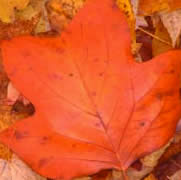 |
Tulip Tree Leaf
/ Canadian Wildlife Service |
Protect First, Restore Second and
Keep What Exists
It is most efficient and effective to maintain biodiversity by
protecting existing wildlife habitat, which already supports wild
populations. Project planning should seek to ensure, above all else,
that existing habitat is not lost.
Maintaining biodiversity extends beyond protecting habitat to the
thresholds within the Framework. The Framework
provides guidance on the minimum habitat required to begin to support
viable wildlife populations and should be seen as starting point
not a final goal. Even watersheds that have abundant high-quality
habitat may suffer negative, and possibly irreversible, losses of
wildlife when habitat is lost or degraded.
The Remedial Action Plan Connection
In 1986, through the Great Lakes Water Quality Agreement,
the United States and Canada agreed to clean up 43 AOCs across
the Great Lakes basin, which have impairments such as contaminated
sediments, eutrophication (excess nutrients), degraded fish
and wildlife populations, and loss of fish and wildlife habitat.
Over a decade later, comprehensive Remedial Action Plans (RAPs)
document implementation strategies designed to lead to the
rehabilitation of AOCs. Considerable progress has been made
in rehabilitating and protecting fish and wildlife habitat
in these areas and elsewhere in the Great Lakes basin. To
date, two of the 17 original Canadian AOCs (Collingwood Harbour
and Severn Sound) are no longer designated as AOCs.
The guidelines contained in the Framework
were developed to help RAP teams devise criteria to measure
progress toward “delisting” an AOC and, after
delisting, to provide further habitat restoration guidance.
Innovative fish and wildlife rehabilitation planning and implementation
initiatives first conducted in AOCs are now finding widespread
application in other jurisdictions. |

Top
 |
Upland Forest /
Canadian Wildlife Service |
Pay Attention to History
Past and present conditions should guide restoration decisions.
A review of the original habitat conditions can be used to establish
historically-appropriate targets. For example, if prior to European
settlement a watershed was comprised of 60 percent wetland cover
and the current amount of wetland is 15 percent, the locally established
target would be higher than the 10 percent guideline suggested in
the Framework. While the historic condition
provides the direction for restoration, the existing condition indicates
how far the system is from being healthy and what needs to be improved.
Knowledge of the magnitude of impacts on habitat helps to envision
what might reasonably be achieved with existing restoration technology
and land-use patterns. However, in some urban watersheds viable
wildlife habitat can only be provided partially through restoration
and creation of habitat that emulates pre-European settlement conditions.
New baselines for habitat and ecosystem functions may have to be
established, and innovative systems devised to compensate for the
effects of lost habitat and to mitigate the impact of urban centres
on the surrounding landscape.
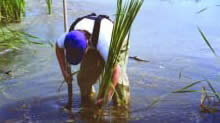 |
Planting to Restore
Wetlands / Canadian Wildlife Service |
Special Species
The Framework gives general guidance for
providing wildlife habitat. Specific habitat requirements are often
considered for key or targeted species present within the watershed
or local area. Their presence will likely be a driving force in
the prioritization of habitat rehabilitation and protection projects.
Whenever possible, projects should benefit species which are designated
federally under the Species at Risk Act or
provincially under the Endangered Species Act.
Plans for habitat rehabilitation should take into account attributes
that would benefit such species.
The Greater Landscape
The guidelines and thresholds in the Framework
are not landscape or watershed specific. Restoration activities
better address ecosystem integrity guidelines when considered in
the context of surrounding land uses. A matrix of varying proportions
of rural and urban land uses and cover types influences the quality
of individual habitats, ecological functions, and composition of
flora and fauna species. For example, a given percentage of forest
cover in a largely urban watershed may not provide habitat for the
same number of forest bird species as it might in a rural landscape.
Other natural heritage plans should also be considered. Broader
strategies such as the Big Picture project for Ontario’s Carolinian
life zone can help to link local strategies to larger landscapes
or may provide further guidance for priority restoration and protection
projects.

Top
 |
White Bog Orchid
/ Graham Bryan |
The Guidelines
Wetland Habitat Guidelines
Wetland loss and degradation have been significant, particularly
in southern Ontario. A high proportion of Great Lakes fish and wildlife
species, including many species at risk, inhabit wetlands during
part of their life cycles. Wetlands provide essential habitat and
also perform many water quantity and quality improvement functions,
including attenuating stream flows and filtering sediments.
Ten percent of a watershed,
and six percent of any sub-watershed should be comprised of wetlands
Approximately 70 percent of southern Ontario’s original wetlands
have been lost. Experience in the Great Lakes basin has shown that
when wetlands comprise about 10 percent of a watershed, flooding
is greatly reduced and base flows are better maintained. Wetlands
should be well distributed across each sub-watershed.
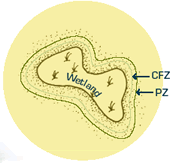 |
Adjacent Vegetation:
Critical Function Zones and Protection Zones |
The Critical Function Zone
and Protection Zone of a wetland should be naturally vegetated
Uplands adjacent to wetlands provide a variety of critical functions
for wetland-associated fauna. Part of this upland is the Critical
Function Zone (CFZ) – an area within which functions and attributes
related to the wetland occur. This area could include nesting habitat
for wetland waterfowl or a groundwater recharge area important for
wetland function. The CFZ needs to be protected from adverse affects
arising outside of the wetland, such as contaminants and intrusions,
by a Protection Zone (PZ). The PZ is in effect a buffer or filter
strip, varying in size with required function. The combined zones
represent the naturally vegetated adjacent lands needed around a
wetland. The CFZ for attributes associated with wetlands can only
be determined based on site-specific knowledge of those attributes
and their sensitivities, and on management objectives. Where the
CFZ is not derived from site-specific characteristics, the following
are minimum guidelines:
- the catchment of a bog should be naturally vegetated;
- 100 metres adjacent to a fen should be naturally vegetated or
a distance as determined by a hydrological study – whichever
is greater, and;
- 100 metres adjacent to swamps and marshes should be naturally
vegetated.
Rehabilitation activities
should focus on swamp and marsh wetland types
There are four types of wetlands in the Great Lakes basin: marshes,
swamps, bogs and fens. Bogs and fens are rare habitats in the lower
Great Lakes and are highly susceptible to changes in nutrient and
water inputs, making them very difficult to rehabilitate once disturbed.
The best management strategy for these types of wetlands is to protect
them by securing their water sources and not altering their watersheds.
Marshes are more readily restored due to their dynamic water and
nutrient regime, and related higher primary productivity. A newly-created
marsh exhibits some functions within a year or two. It may be several
years before a created swamp becomes partially functional and a
few decades may pass before trees have had sufficient time to grow
and improve the swamp’s function.
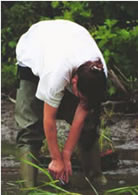 |
Coastal Wetland
Restoration / Canadian Wildlife Service |
Wetland rehabilitation should
be strategically located in a watershed
Wetlands are beneficial anywhere within a watershed; however, particular
ecological functions can be met by restoring wetlands in key locations,
such as headwater areas to protect the sources of streams, groundwater
recharge areas for maintaining stream flow and temperature, floodplains
for flood attenuation and water storage, and coastal areas for fish
production. Special attention should be paid to historic wetland
locations and the site and soil conditions.
Swamps and marshes should
be of a sufficient size to support habitat heterogeneity and there
should be a variety of wetlands across a landscape
Large swamps tend to have greater habitat heterogeneity (varied
habitat), which in turn tends to support more wildlife species.
Marshes also benefit from this effect in terms of “interspersion”
or juxtaposition of different marsh communities (e.g., emergent
versus submerged vegetation). Smaller marshes will be less likely
to have multiple marsh communities of sufficient size for use by
wildlife. However, wetlands of various sizes, types, and hydroperiods
will be used by wildlife, including small wetlands used by breeding
amphibians and seasonally flooded wetlands used for fish spawning.
 |
Swamps and marshes:
regularly-shaped and irregularly-shaped |
Regularly-shaped swamps
Swamps should be regularly shaped with minimum edge and maximum
interior habitat to provide for species intolerant of the forest
edge.

Top
Forest Habitat Guidelines
The amount of forest cover, size of individual forest patches,
forest type, and linkages to other patches in a landscape determine
their ability to support wildlife species which depend upon them.
This is particularly true for mammals and forest interior birds
that require extensive forests (note that forest birds are used
as indicators of the quality of the forest because they are easily
surveyed and more is known about their habitat requirements and
distribution than any other group of wildlife).
Thirty percent forest cover
As the amount of forest habitat in an area declines, so does the
number and percent of expected forest bird species within the range.
In one study, statistical analysis was used to demonstrate that
forest interior birds continued to increase in number to at least
35 percent forest cover at a scale of 10 000 hectares; to approximately
24 percent at a scale of 40 000 hectares, and; up to 20 percent
at a scale of 90 000 to 160 000 hectares. This analysis points out
that the Framework’s guidelines work
best when they are fine-tuned for local variables, including the
scale at which they are applied.
At least one 200-hectare forest
patch that is a minimum of 500 metres wide
 |
Forest patches |
A number of reports have demonstrated that the larger a forest
habitat is, the more species it will support. A range of forest
patch sizes has been suggested for different species. In one study,
four large forest patches ranging in size from 140 to 201 hectares
were surveyed in the Severn Sound AOC. From this work, it was determined
that a single tract of 140 hectares was too small to support the
regional forest bird community. At least one 200-hectare patch on
a landscape unit should support over 80 percent of expected forest
bird species. Several large tracts (i.e., greater than 200 hectares)
are recommended to support 90 to 100 percent of expected forest
bird species.
Ten percent of the watershed
should be forest cover 100 metres or further from the forest edge;
Five percent of the watershed should be forest cover 200 metres
or further from the forest edge
 |
Mixed Forest / Canadian
Wildlife Service |
Certain bird species, when breeding, avoid forest edges in small,
fragmented forests. Negative effects of small forests (without 100
or 200-metre forest interior) include increased predation and parasitism,
desiccation by wind, insufficient food, and a higher susceptibility
to catastrophic events such as fire, floods or human disturbances
such as adjacent development. A minimum width of 500 metres is important
in defining the ability of a forest to support edge-intolerant bird
species, which tend to nest 200 metres from the edge. Therefore,
a forest width of 500 metres provides a 100 metre-wide band of habitat
for these species.
Forest patches should be circular
or square in shape
Square or circular habitats provide the greatest amounts of interior
for species such as edge-intolerant birds, while linear or irregularly-shaped
habitats of similar size contain little or no interior. Forested
areas with high interspersion and edge favour common generalist
species, such as House Sparrows, as opposed to the more uncommon
area-sensitive specialists such as Ovenbirds.
Forest patches should be within
two kilometres of one another
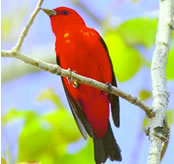 |
Scarlet Tanager
/ Walter B. Fechner |
Studies have found that abundant forest cover within two kilometres
of a particular forest patch is a significant predictor of the presence
of edge-intolerant bird species. Close proximity of forest patches
also facilitates wildlife movement among them. When rehabilitating
habitats, focusing on areas that are near other natural areas is
most effective.
Corridors designed to facilitate
species movement should be a minimum of 50 to 100 metres wide; Corridors
to accommodate breeding habitat must consider target species requirements
Wider corridors are more effective at facilitating species movement.
Suitable habitat must be provided within the corridor for the target
species that are expected to move along it. Vegetation composition
in the corridor should be similar to that within the nodes that
it connects. In addition, the corridor should be continuous, maintaining
a minimum width along its entire length (e.g., 100 metres wide along
the entire corridor).
Watershed forest cover should
be representative of the full diversity of forest types found at
that latitude
Although forest cover may be plentiful in a watershed, it may consist
of early to mid-successional plant communities, mostly conifer plantations,
or a variety of non-native species. Choosing forest types for restoration
requires some knowledge of the pre-settlement landscape as guidance.

Top
Riparian Habitat Guidelines
Riparian refers to all habitat within a stream corridor or valley,
particularly the shrubs and trees on the stream bank. Riparian habitats
provide important fish and wildlife habitats, such as natural linkages
among different habitat features that create critically important
wildlife migration corridors.
Seventy-five percent of stream
length naturally vegetated
Stream degradation occurs when riparian vegetation amounts to less
than 75 percent cover along streams. In particular, first to third
order streams in headwater areas (cold-water or cool-water streams)
with permeable soils benefit greatly from shading and leaf matter
provided by adjacent overhanging vegetation, which serves as food
for benthic invertebrates. Streams of all orders benefit from being
vegetated (even if the amount of vegetation is less than 75 percent)
because riparian vegetation maintains water temperature, ensures
bank stability, filters out excess nutrients and suspended solids,
protects fish communities, and supports good water quality.
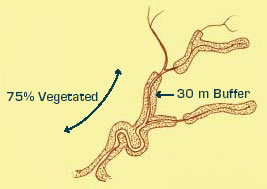 |
Stream buffer |
Thirty-metre wide stream buffers
Ideally, streams should have a 30-metre wide, naturally vegetated
buffer on both sides to reduce nutrients and sediments reaching
the stream. When choosing a suitable stream buffer width for specific
sites, take into account factors such as the nature of the watercourse
(stream order and class), soil types, slopes, and adjacent uses.
Buffer widths from three to 200 metres may be appropriate depending
upon rehabilitation goals.
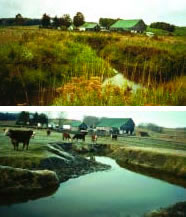 |
Buffers decrease
sedimentation and provide a wildlife corridor / Great Lakes
Sustainability Fund |
Total Suspended Sediment (TSS)
concentrations below 25 milligrams per litre or be consistent with
Canadian Council of Ministers of the Environment (1999) guidelines
regarding Protection of Aquatic Life
Suspended sediments may affect aquatic habitat adversely by filling
in interstices of coarse substrate, thereby limiting habitats for
aquatic invertebrates. Under extreme conditions, fish eggs may be
smothered, fish that feed by sight may have difficulty finding food,
gills may become clogged, and disease may occur. Plant communities
may be affected adversely by reduced light penetration into the
water column (i.e., reductions in the extent of submerged vegetation).
Maintaining TSS values below 25 milligrams per litre by implementing
urban stormwater controls and rural non-point source best management
practices should result in lower turbidity and fewer harmful effects
on the stream and its biota.
Less than 10 percent of an
urbanized watershed should be impervious
Less than 10 percent imperviousness (hard surfaces) in an urbanized
watershed should maintain stream water quality and quantity, and
leave biodiversity relatively unimpaired. An upper limit of 30 percent
represents a threshold for degraded systems. The goal should be
to avoid extreme peak flows through incrementally minimizing hard
surfaces, making use of porous pavements, and disconnecting roof
downspouts.

Top
Case Study
The Terrestrial
Natural Heritage Approach
The Toronto and Region Conservation
Authority’s (TRCA) approach to terrestrial natural heritage
planning involves measuring the condition of natural systems
in a watershed. The basic unit of measurement is the individual
habitat patch. Values for patches can be combined to assess
natural systems at various scales such as subwatershed, watershed,
municipality, and so on. The result is a value for a whole
natural system based on:
- quantity (the percent natural cover
in a region);
- quality (the average habitat patch
size, shape and matrix influence);
- distribution (the distribution of
that quantity and quality of natural cover across the landscape
or watershed).
|
 |
Blue Flag Iris /
Douglas A. Wilcox |
Identifying and setting targets based on quantity, size and shape
of habitat patches is similar to the Framework
approach, but the Terrestrial Natural Heritage Approach also recognizes
a matrix influence. The matrix influence is a measure of the positive
or negative influence that a habitat patch receives from its surroundings.
Numeric values are assigned to the effect that different land uses
(within two kilometres) will have on a given patch of habitat and
individual patches are scored as to matrix influence. By averaging
scores across an area, knowledge can be gained as to the health
of the overall natural system in relation to land-use planning decisions.
 |
Rocky Stream / Canadian
Wildlife Service |
Urban land uses generally have a negative impact on wetlands, meadows
and other natural habitats because they block the movement of species
and energy, and harbour negative influences such as pollution, refuse,
recreational pressures, dogs and cats, invasive species, and more.
Therefore, they receive a base value of negative one. Agricultural
land uses are more conducive to species movements and can have positive
and negative impacts for biodiversity. Their value is generally
seen as neutral with a point value of zero. A habitat patch can
have a synergistic and beneficial relationship with other natural
cover in the surrounding area, and hence natural cover is assessed
a point value of one.
By accounting for matrix influence, it is possible to refine choices
of desirable locations for restoration, and to gain a clearer understanding
of the condition of natural systems and of the potential consequences
of planning and restoration actions on the future condition of those
systems.
Duffins Creek watershed
In developing the Watershed Plan for Duffins Creek, the natural
system was evaluated and, through modeling of an improved natural
system, targets were set for the amount and distribution of natural
cover, the size and shape of habitat patches, and the matrix influence
within two kilometres of habitat patches. Initially, the existing
natural cover in the Duffins Creek watershed was identified as individual
habitat patches, which were then scored to reveal differences in
the quality of patches and, by extension, the average quality of
the natural system throughout the watershed. Next, planned urbanization
and other human impacts, such as roads, were mapped. Lastly, the
projected or targeted extent of the improved natural system was
mapped. The projected extent of natural cover reflected where habitat
could best be restored to achieve the highest scores for patch quality
based on the location in the watershed, size, shape and matrix influence.
Links to Local Municipal Land-Use
Planning
The Framework can be applied in land-use
planning to address specific issues and needs from a scientific
basis. Use of the sciencebased guidelines to formulate planning
and policy decisions can make such decisions more defensible and
provide a rationale for directly protecting habitat or initiating
restoration projects. It can guide protection of existing types
of habitat to ensure sensitive species, such as forest birds, will
have sufficient habitat to breed. It can quantify adequate wetland
coverage to ensure flood suppression.
Habitat protection can be linked with restoration to provide sustainable
natural heritage systems. Currently, Official Plans recognize natural
heritage in the form of existing habitat. This habitat is often
fragmented or reduced and may not yield viable habitat for wildlife.
The Framework can be used to proactively
identify and set aside lands where restoration can occur to make
the existing natural heritage system more complete, through local
restoration plans or actually within Official Plans.
There may be opportunities to extract, or adapt, guidelines from
the Framework and build them into Official
Plans. In one example, the City of Windsor developed a policy on
a particular project to minimize impervious surface treatments using
the impervious surface area guideline in the Framework.

Top
Case Study
Adopting and
Adapting Framework Guidelines in Severn Sound
The Severn Sound AOC was recently removed
from the list of Great Lakes AOCs, partly due to the restoration
of fish and wildlife habitat. One of seven delisting objectives
set to guide restoration efforts was “to rehabilitate
tributaries and riparian areas for fish and wildlife habitats”.
Various indicators were used to measure restoration progress
toward objectives, with many indicators introduced or modified
while restoration was proceeding from the late 1980s to 2002.
These included guidelines from the first edition of the Framework,
which were either directly adopted or adapted to local conditions
as indicators to measure success in meeting delisting objectives
(see accompanying table).
|
 |
Stream with Riparian
Cover / Eric Dresser |
Adopting
Framework guidelines
Many Framework guidelines were used directly
as upland habitat indicators. Given past and present local conditions,
it was deemed reasonable to adopt Framework
guidelines, such as minimum 30 percent forest cover and the presence
of at least one 200-hectare forest patch that is minimum 500 metres
wide.
Adapting
Framework guidelines
Some Framework guidelines were adapted for
local conditions and then used as indicators, reflecting available
resources and an effort to prioritize efforts where restoration
would be most beneficial. For example, the Framework
guideline 75 percent of stream length should be
naturally vegetated was modified to: At least
75 percent of first to third order streams should be naturally vegetated.
Importance of local conditions
Studies were conducted of local conditions to refine restoration
planning and, if needed, modify Framework guidelines for use in
the AOC. One general Framework rationale is that upstream stream
reaches are colder, but it was found in the AOC, due to groundwater
inputs, that many higher order streams, even fourth or fifth order
streams, were colder than first or second order streams. Hence,
vegetation would play a smaller role in maintaining cold-water stream
systems. Moreover, forest cover was not established along all stream
banks due to natural meander belts and marsh vegetation. These reaches,
however, naturally supported cool and cold water habitat conditions
that would be expected on a forested reach.
Identifying habitat and changes
in habitat
Geographic Information System (GIS) mapping based on current and
historic aerial photos and maps allowed wetland, forest and riparian
habitat coverage to be assessed and compared over the years, in
some cases as far back as 1953. Through this comparison, trends
in habitat could be noted and targets for the AOC refined. GIS analysis
also allowed restoration projects to be located to best meet habitat
targets.
Results
Overall forest cover increased in most sub-watersheds due to planting
and natural succession, although restoration and protection will
be needed to provide adequate interior forest habitat to address
ongoing residential development. There was a steady increase in
natural vegetation along stream courses, with much of this success
attributable to restoration efforts and better stream buffer awareness
among landowners. The percent wetland area guideline of 10 percent
of watershed was not met, with the exception of Sturgeon River and
Wye River watersheds. The percent wetland area guideline of six
percent for sub-watersheds was generally met with the exception
of the Coldwater River.
The Severn Sound AOC guidelines
and habitat trends
| Guidelines |
Local Target |
1982 |
1998 |
Difference |
| Forest
Habitat Guidelines |
|
|
|
|
| Forest cover |
>30% |
32% |
38% |
6% |
| Size of largest patch |
>100 ha |
163 ha |
199 ha |
36 ha |
| Forest >100 m from edge |
>10% |
6% |
11% |
5% |
| Forest >200 m from edge |
>5% |
1% |
3% |
2% |
| Riparian
Habitat Targets |
|
|
|
|
| First to third order streams
with natural vegetation |
>75% |
47% |
57% |
10% |
| First to third order streams
with >30 m natural vegetation |
>75% |
29% |
40% |
11% |
| First to third order streams
with natural vegetation plus wetlands |
>75% |
57% |
64% |
7% |
| First to third order streams
with >30 m natural vegetation plus wetlands |
>75% |
36% |
44% |
8% |
| Wetland Habitat Targets |
|
|
|
|
| Wetlands in watershed |
>10%
(sub >6%) |
7% |
7% |
|
| Amount of vegetation: mean width |
>240 m |
71 m |
122 m |
51 m |
An example of strategic restoration
The effect of a 1991 Severn Sound AOC restoration project is shown
in the diagrams below. There was an increase in habitat between
1981 and 1998 in terms of percentage of vegetated stream length
and percentage of stream with a 30-metre buffer.
Plan for the long term
Measuring change in ecosystem health is difficult. Full benefits
will not be seen until restoration sites mature. Also, different
restoration projects took place at different times, and in the interim
land development and other human activities cause ongoing habitat
loss. Vigilance and ongoing restoration will be needed to maintain
adequate habitat in Severn Sound and elsewhere in the Great Lakes
basin.
For more information, or to request a copy of the full guide, How
Much Habitat is Enough? (Second Edition), please contact:
Environment Canada
Canadian Wildlife Service
4905 Dufferin Street
Downsview, Ontario M3H 5T4
Tel: (416) 739-5830
Fax: (416) 739-5845
E-mail: Wildlife.Ontario@ec.gc.ca
Aussi disponible en français sous le titre : Quand
l’habitat est-il suffisant?
This fact sheet was prepared by Graham Bryan of Environment
Canada. This project received funding support from Environment Canada’s
Great Lakes Sustainability Fund.

Top
Click
here to view / print this document in PDF format
|